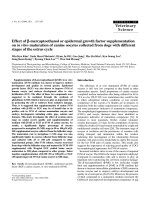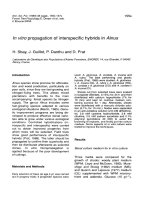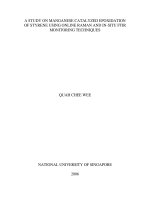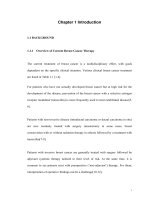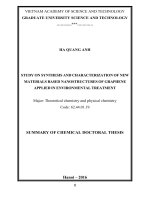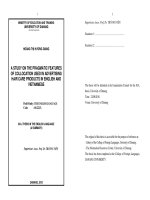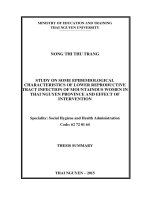Study on in vitro propagation of lavandula dentata
Bạn đang xem bản rút gọn của tài liệu. Xem và tải ngay bản đầy đủ của tài liệu tại đây (2.4 MB, 65 trang )
VIETNAM NATIONAL UNIVERSITY OF AGRICULTURE
FACULTY OF BIOTECHNOLOGY
GRADUATION THESIS
TITLE:
STUDY ON IN VITRO PROPAGATION
OF LAVANDULA DENTATA
Instructor:
Assoc. Prof. Dr. NGUYEN THANH HAI
(Deputy Head, Department of Plant Biotechnology)
Student:
VU TRONG HIEU
Student code: 610615
Class:
K61-CNSHE
Hanoi – 2021
DECLARATION
The thesis entitled "study in in vitro propagation of Lavandula dentata" is
conducted under the supervision of Assoc. Prof. Dr. NGUYEN THANH HAI and
Master PHAM THI THU HANG.
I declare that the information reported in the current thesis is the result of my
own work, except where the reference is made.
I declare that all information and references in this thesis have been clearly
stated the origin, name of author, name of work, time and place of study.
I accept full responsibility for this declaration.
Hanoi, January, 2021
Signature
Vũ Trọng Hiếu
i
ACKNOWLEDGEMENTS
This study has been completed thanks to the help of many individuals and
organizations from whom I have received support. I would like to express my
appreciation to all of them.
First of all, I would like to send my sincere thanks to the Vietnam National
University of Agriculture for facilitating my graduation thesis, sincerely thank the
Dean of the Faculty of Biotechnology and all the teachers in the Department of Plant
Biotechnology- Faculty of Biotechnology for their wholehearted guidance, knowledge
addition and assistance during the internship at the laboratory.
In particular, I would like to express my gratitude to Assoc. Prof. Dr. NGUYEN
THANH HAI and Master PHAM THI THU HANG in the Department of Plant
Biotechnology- Faculty of Biotechnology- Vietnam National University of Agriculture
for taking the time and enthusiasm to directly guide, help throughout the process of
graduation.
I also thank all those who are doing research at the laboratory for helping and
facilitating me to complete my thesis well.
Hanoi, January, 2021
Signature
Vũ Trọng Hiếu
ii
TABLE OF CONTENTS
ACKNOWLEDGEMENTS ........................................................................................... ii
TABLE OF CONTENTS .............................................................................................. iii
LIST OF ABBREVIATIONS .........................................................................................v
LIST OF TABLES .........................................................................................................vi
LIST OF FIGURES ...................................................................................................... vii
SUMMARY................................................................................................................. viii
CHAPTER I. INTRODUCTION ....................................................................................1
1.1. Abstract ..................................................................................................................... 1
1.2. Objective ................................................................................................................... 1
CHAPTER 2. OVERVIEW OF REFERENCE .............................................................. 2
2.1. Introduction of Lavandula genus.............................................................................. 2
2.1.1. The distribution of Lavandula genus ..................................................................... 2
2.1.2. The classification of Lavandula genus .................................................................. 4
2.2. Introduction of Lavandula dentata ........................................................................... 7
2.2.1. Classification and distribution .............................................................................. 7
2.2.2. Characteristics ...................................................................................................... 9
2.3. Traditional propagation methods of Lavandula dentata ........................................ 10
2.3.1. Cutting Propagation ............................................................................................ 11
2.3.2. Layering Propagation ......................................................................................... 11
2.3.3. Division Propagation .......................................................................................... 11
2.3.4. Seed Propagation ................................................................................................ 12
2.4. Research and application of tissue culture in propagation of Lavandula dentata in
Vietnam and around the world ...................................................................................... 12
2.5. Overview of plant cells and tissue culture .............................................................. 14
2.5.1. Introduction ......................................................................................................... 14
2.5.2. Plant tissue culture medium ................................................................................ 15
iii
CHAPTER III. SUBJECTS, MATERIALS, CONTENT AND METHODOLOGY OF
RESEARCH ..................................................................................................................19
3.1. Subjects and materials ............................................................................................ 19
3.1.1. Subjects ................................................................................................................ 19
3.1.2. Materials .............................................................................................................. 19
3.1.3. Place and time ..................................................................................................... 19
3.2. Contents and methodology of research .................................................................. 19
3.2.1. Contents of research ............................................................................................ 19
3.2.2. Methodology of research ..................................................................................... 22
3.2.3. Tracking criteria .................................................................................................. 22
3.2.4. Data processing methods .................................................................................... 22
PART IV. RESULT AND DISCUSSION ....................................................................23
4.1. Effect of BA on the multiplication of Lavandula dentata shoots .......................... 23
4.2. Effect of BA and Kinetin on the multiplication of Lavandula dentata shoots ...... 25
4.3. Effect of BA and IBA on the multiplication of Lavandula dentata shoots............ 27
4.4. Effect of BA and α - NAA on the multiplication of Lavandula dentata shoots .... 30
4.5. Effect of BA and IAA on the multiplication of Lavandula dentata shoots ........... 32
4.6. Effect of IBA and α - NAA on rooting of Lavandula dentata shoots ................... 34
CONCLUSIONS AND RECOMMENDATIONS ........................................................38
REFERENCE ................................................................................................................39
APPENDIX: TABLES OF DATA PROCESSING ......................................................41
iv
LIST OF ABBREVIATIONS
Abbreviations
Annotate
MS
Murashige and Skoog medium
CT
Formula
CV
Coefficient of variation
LSD5%
Least significant differences
BA
Benzylidenes
IAA
Indole-3-acetic acid
IBA
Indole-3-butyric acid
α - NAA
1-naphthaleneacetic acid
v
LIST OF TABLES
Table 1. Several major growth regulators are used in plant tissue culture…................ 17
Table 2: Results and data processing of experiment 1 .................................................. 23
Table 3: Results and data processing of experiment 2 .................................................. 25
Table 4: Results and data processing of experiment 3 .................................................. 28
Table 5: Results and data processing of experiment 4 .................................................. 30
Table 6: Results of data processing of experiment 5..................................................... 33
Table 7: Results of data processing of experiment 6..................................................... 35
vi
LIST OF FIGURES
Figure 1: Lavandula genus (source: Internet) ................................................................. 2
Figure 2: The distribution of Lavandula dentata ........................................................... 8
Figure 3: Lavandula dentata; .......................................................................................... 9
Figure 4: Effect of BA on the multiplication of Lavandula dentata shoots (after
4 weeks) ....................................................................................................... 24
Figure 5: Chart shows the effect of BA on the multiplication of Lavandula
dentata shoots .............................................................................................. 24
Figure 6: Effect of BA and Kinetin on the multiplication of Lavandula dentata
shoots (after 4 weeks) .................................................................................. 26
Figure 7: Chart shows the effect of BA and Kinetin on the multiplication of
Lavandula dentata shoots ............................................................................ 26
Figure 8: Effect of BA and IBA on the multiplication of Lavandula dentata
shoots (after 4 weeks) .................................................................................. 28
Figure 9: Chart shows the effect of BA and IBA on the multiplication of
Lavandula dentata shoots ............................................................................ 29
Figure 10: Effect of BA and α - NAA on the multiplication of Lavandula
dentata shoots (after 4 weeks) ..................................................................... 31
Figure 11: Chart shows the effect of BA and α - NAA on the multiplication of
Lavandula dentata shoots ............................................................................ 31
Figure 12: Effect of BA and IAA on the multiplication of Lavandula dentata
shoots (after 4 weeks) .................................................................................. 33
Figure 13:Chart shows the effect of BA and IAA on the multiplication of
Lavandula dentata shoots ............................................................................ 34
Figure 14: Effect of IBA and α - NAA on rooting of Lavandula dentata shoots
(after 6 weeks) .............................................................................................. 36
Figure 15: Chart shows the effect of IBA and NAA on rooting of Lavandula
dentata shoots .............................................................................................. 36
vii
SUMMARY
Tissue culture has been used for diverse purposes, being the regeneration of
explants, during in vitro establishment, a decisive stage to development of this
technique. One of the difficulties encountered in the initial stage, besides
contaminations by microorganisms, is the regeneration of the excised explants, which
normally requires the exogenous source of plant growth regulators. The aim of this
research was to evaluate the effect of plant growth regulators on the regeneration of
Lavandula dentata shoot tips. Shoot samples were excised and placed on MS culture
medium containing 30.0 g/L sucrose, 7.0 g/L agar. The experimental design used was
complete randomize design (CRD) with 3 replicates of 10 explants per plot. The
largest multiplication rate was 8.43 obtained on medium containing 1.0 mg/L BA. The
largest height of shoots was recorded on medium containing 1.0 mg/L BA. The most
suitable medium for rooting of Lavandula dentata was MS medium supplemented
with 1.0 mg/L NAA. Plant growth regulators combinations initial development of the
shoot tips is the presence of 1.0 mg/L BA and 0.2 mg/L IAA.
viii
CHAPTER I. INTRODUCTION
1.1. Abstract
Lavender is a sort of blossoming plant that has a place in the mint family. There
are in excess of 30 types of lavender that original from Mediterranean area, northern
and eastern pieces of Africa and southwestern Asia. Lavender fills in dry, radiant
regions on all around depleted soils. Synthetic compounds separated from lavender
have useful impact on the human wellbeing.
Lavandula dentata are some of the most popular ornamental and medicinal
plants with great economic values. These species are vegetative propagated by stem
cuttings. However, the poor rooting ability and vulnerability of plantlets to
contamination are major limiting factors for propagation. In vitro culture methods are
suitable to overcome these limitations.
In Vietnam, only grown in Da Lat and known by many people through
perfumes, aromatic bags and medicinal products. The demand for using Lavender
flowers in medicine, beauty, cuisine ... in Vietnam is increasing. However, the
domestic supply is not guaranteed due to difficulties in the process of cultivation and
care. Especially the quality of seedlings.
This graduate thesis presented of in vitro propagation of Lavandula dentata
towards development of additional and alternative sources of material.
1.2. Objective
Determine effect of growth regulators on in vitro multiplication of Lavandula
dentata.
Determine the appropriate rooting medium for the complete Lavandula dentata.
1
CHAPTER 2. OVERVIEW OF REFERENCE
2.1. Introduction of Lavandula genus
2.1.1. The distribution of Lavandula genus
According to Wikipedia, Lavandula (common name Lavender) is a genus 47
known species of flowering plants in the mint family, Lamiaceae. Name "Lavandula"
originates from Latin verb "lavare", which means "to wash".
Figure 1: Lavandula genus (source: Internet)
2
It has been known for thousands of years since Ancient Greece, originating in
the Mediterranean region. With characteristic purple color expressing romance and
great uses, Lavender flowers were planted by the Romans.
Fundamental oils separated from the blossoms of lavender are hugely utilized in
the business of scents and beautifying agents. On account of these impacts, lavender is
regularly utilized in the creation of moisturizers, cleansers, shampoos and skin health
management items.
Essential oils of lavender are often used in aromatherapy because they produce
relaxing effect in most people. Unlike humans, pests such as mice, flies, mosquitoes
and moths cannot stand smell of lavender. Many people keep bunches of lavender in
their homes to repel unwanted animals.
Lavender has antiseptic, antibacterial, analgesic and anti-depressant properties.
It is used in treatment of headache, insect bites, burns, acne, muscle and joint ache and
insomnia in the folk medicine.
Lavender is used in human diet as an ingredient of various sweet (cakes,
chocolates...) and salty meals (it is often combined with cheese). It can be also
consumed in the form or tea or honey (made of nectar from lavender flowers).
Lavender can be used as natural "insecticide". When planted near the roses,
lavender keeps aphids on a safe distance.
Ancient Egyptians were using lavender during the process of mummification.
Europeans were wearing bracelets made of lavender to protect themselves
against plague and other dangerous diseases in the 13th century.
Lavender was used in art during the period of Renaissance. Painters (including
famous Rubens) were using lavender to improve quality of colors on the paintings.
Nowadays, the genus lavender is found mainly in Cape Verde and the Canary
Islands, and from Europe through north and east Africa, the Mediterranean, southwest
Asia to southeast India, everywhere in Europe.
3
The genus includes annual or short-lived herbaceous perennial plants, and
shrub-like perennials, subshrubs or small shrubs. Leaf shape is diverse across the
genus. They are simple in some commonly cultivated species; in other species, they
are pinnately toothed, or pinnate, sometimes multiple pinnate and dissected. In most
species the leaves are covered in fine hairs or indumentum, which normally contain the
essential oils.
Flowers are borne in whorls, held on spikes rising above the foliage, the spikes
being branched in some species. Some species produce colored bracts at the apices.
The flowers may be blue, violet or lilac in the wild species, occasionally blackish
purple or yellowish. The calyx is tubular. The corolla is also tubular, usually with five
lobes.
2.1.2. The classification of Lavandula genus
A. Subgenus Lavandula
1. Section Lavandula (3 species)
Lavandula angustifolia
subsp. angustifolia from Catalonia and the Pyrenees.
subsp. pyrenaica from southeast France and adjacent areas of Italy.
Lavandula latifolia – native to central Portugal, central and eastern Spain,
southern France, northern Italy.
Lavandula lanata – native to southern Spain.
2. Section Dentatae (1 species)
Lavandula dentata L. from eastern Spain, northern Algeria and Morocco,
southwestern Morocco.
3. Section Stoechas (3 species)
Lavandula stoechas L.
4
subsp. Stoechas from mostly coastal regions of eastern Spain, southern France,
western Italy, Greece, Bulgaria, Mediterranean Turkey, Levantine coast, and most
Mediterranean islands.
subsp. Luisieri native to coastal and inland Portugal and adjacent Spain.
Lavandula pedunculata
subsp. pedunculata – Spain and Portugal.
subsp. cariensis – from western Turkey and southern Bulgaria.
subsp. atlantica – from montane Morocco.
subsp. lusitanica – southern Portugal and southwestern Spain.
subsp. sampaiana – from Portugal and southwest Spain.
Lavandula viridis – native to southwest Spain, southern Portugal, and
possibly also to Madeira.
B. Subgenus Fabricia
4. Section Pterostoechas (16 species)
Lavandula multifida L. – is native to a wide range including Morocco,
southern Portugal and Spain, norther Algeria, Tunisia, Tripolitania, Calabria and
Sicily, with isolated populations in the Nile valley.
Lavandula canariensis from the Canaries.
subsp. palmensis – from La Palma.
subsp. hierrensis – from El Hierro.
subsp. canariensis – from Tenerife.
subsp. canariae – from Gran Canaria.
subsp. fuerteventurae – from Fuerteventura.
subsp. gomerensis – from La Gomera.
subsp. lancerottensis – from Lanzarote.
Lavandula minutolii – Canary Isles.
subsp. Minutolii
subsp. tenuipinna
Lavandula bramwellii – from Gran Canaria.
Lavandula pinnata L. – from the Canaries and also Madeira.
5
Lavandula buchii– Tenerife.
Lavandula rotundifolia – Cape Verde Islands.
Lavandula maroccana – Atlas mountain of Morocco.
Lavandula tenuisecta– Atlas mountain in Morocco.
Lavandula rejdalii – Morocco.
Lavandula mairei – Morocco.
Lavandula coronopifolia– This has a wide distribution, from Cape Verde
across North Africa, the northeast of tropical Africa, Arabia to eastern Iran.
Lavandula saharica – southern Algeria and nearby regions.
Lavandula antineae – central Sahara region.
subsp. Antinae
subsp. Marrana
subsp. tibestica
Lavandula pubescens – from Egypt and Eritrea, Sinai, Israel and Palestine,
Jordan, western Arabian Peninsula to Yemen.
Lavandula citriodora – southwestern Arabian Peninsula.
5. Section Subnudae (10 species)
Lavandula subnuda– from the mountains of Oman and the United Arab
Emirates.
Lavandula macra– southern Arabian Peninsula and northern Somalia.
Lavandula dhofarensis– from Dhofar in southern Oman.
subsp. dhofarensis
subsp. ayunensis
Lavandula samhanensis – Dhofar, Oman.
Lavandula setifera – from coastal regions of Yemen and Somalia.
Lavandula qishnensis – southern Yemen.
Lavandula nimmoi – from Socotra.
Lavandula galgalloensis – northern Somalia.
6
Lavandula aristibracteata – northern Somalia.
Lavandula somaliensis – northern Somalia.
6. Section Chaetostachys (2 species)
Lavandula bipinnata – from the Deccan peninsula and central north India.
Lavandula gibsonii – Western Ghats, India.
7. Section Hasikenses (2 species)
Lavandula hasikensis – Oman.
Lavandula sublepidota – from in southern Iran.
C. Subgenus Sabaudia
8. Section Sabaudia (2 species)
Lavandula atriplicifolia – western Arabian Peninsula, Egypt.
Lavandula erythraeae – from Eritrea.
2.2. Introduction of Lavandula dentata
2.2.1. Classification and distribution
Taxonomy: Lavandula dentata was described by Carlos Linnaeus published in
Species Plantarum Page. 572, in 1753.
Kingdom
Plantae
Clade
Tracheophytes
Clade
Angiosperms
Clade
Eudicots
Clade
Asterids
Order
Lamiales
Family
Lamiaceae
Genus
Lavandula
Species
L. dentata
7
Etymology: Dentata in Epithet Latin which means "toothed."
Distribution: Lavandula dentata is distributed mainly in temperate regions such
as Australia, the North and South America coasts, especially the western
Mediterranean.
A
B
Figure 2: The distribution of Lavandula dentata
A. in the world; B: in the Mediterranean
( sourse: the internet, 2018)
8
2.2.2. Characteristics
Lavandula dentata is a perennial, aromatic robust-body.
Sun exposure: Full sun
Growth rate: Medium
Blooming time: Mid-Summer and late summer
Soil type: Normal or sandy
Soil pH: Neutral or alkaline
Soil moisture: Dry
C
A
B
D
Figure 3: Lavandula Dentata (source: the internet);
A. Shoot and leaves; B. Root; C. Flower; D. Sheet
9
Shoot
Lavandula dentata is the herbaceous plant that small dark green soft body and
erect. It reaches a height of between 40 and 80 cm.
Root
The roots of the Lavandula dentata are fibrous roots, about 40-50 cm in leigh.
Because they live in dry conditions, the roots of this plant are fragile and weak.
Leaves
Leaves from the linear oblong about 0.9 to 4.5 cm lanceolate, with jagged,
lobed or cleft margins and rounded or blunt teeth. It is greyish green on top, grey by
the underside. They are often covered with fine hairs.
Flower
Lavandula dentata has the bisexual flower. Lavender produces blue, violet or
lilac flowers. They are arranged circularly (grow in whorls) on top of the floral stalks,
without flowers in the lateral bud. Inflorescence is about 2.5 to 5 cm in leigh with 8 to
12 flowers. Corolla is 0.8 cm in leigh, bilabiate: bladed upper lip, trilobate lower lip
with 4 stamens.
Fruit and seed
Fruit of lavender is 4-nutlets. They have smooth texture and ovoid or oblong
shape.
2.3. Traditional propagation methods of Lavandula dentata
In an article titled “The Best Ways to Propagate Lavender Plants”, published in
2018, Mrs. Sasha Degnan mentioned traditional propagation methods of Lavandula
dentata.
10
2.3.1. Cutting Propagation
Cutting propagation is the simplest method of growing new lavender plants,
which makes it the best method for beginner gardeners. Softwood cuttings taken in
spring from new growth and semi-hardwood cuttings gathered in late summer or early
autumn both works well. Fill a plastic nursery pot with a moist mixture of half sterile
soil and half sand, and be sure to use a pot with drainage holes at the base. Locate a
few 2- to 3-inch-long cuttings from healthy-looking stems and cut them at an angle
using a sharp, sanitized blade. Remove all the leaves from the bottom one-third of the
cutting as well as any flowers or buds from the tip. Dust the cut-end of each cutting
with rooting hormone and then bury the bottom one-third of the cuttings in the
moistened rooting medium. Most lavender cuttings will root in four to six weeks if
they are kept under warm, humid and bright conditions.
2.3.2. Layering Propagation
Another method of propagating lavender plant is layering. Layering means to
start a plant from a living stem while it is still attached to the “mother” plant. It is
achieved by taking a low-growing stem on a healthy, established lavender plant and
bending the midpoint of the stem down toward the ground. After removing the foliage
from the middle portion of the stem, make a shallow wound on the underside of the
stem using a sanitized razor blade. Dust the wound and the surrounding portion of the
stem with rooting hormone; then bury the wounded portion of the stem 1 to 2 inches
below the surface of the soil. Place a stone on it to hold it in place or use a piece of
bent metal to “staple” the stem to the soil. Most stems will root in about eight weeks,
at which point you can sever the stem and transplant the new lavender plant into a pot
of fast-draining soil or directly into the garden.
2.3.3. Division Propagation
Division propagation yields larger, more mature-looking plants faster. Start
divisions in spring or autumn when the plant is growing but not blooming. A hydrated
plant will root better, so give your lavender a deep watering the night before you plan
to divide it. Prepare pots for the divisions before digging up the plant. Use nursery pots
11
that are large enough to accommodate the divisions without overcrowding their roots
and make sure each pot has plenty of drainage holes at the base. Fill the bottom of
each pot with sandy, fast-draining potting soil. Lift the entire plant, root ball and all,
from the soil using a gardening fork or shovel and move it to a shaded location. Divide
the clump into two to three equal-sized portions, each with an equal share of roots and
stems. Pot them, water them well and keep them under sheltered conditions until they
establish new roots. Spring-divided lavenders can be planted in autumn, and autumndivided lavenders can be planted the following spring.
2.3.4. Seed Propagation
The resulting seedlings may not resemble the parent plant, but they may grow
into a whole new strain found only in your garden. Start lavender seeds indoors in
spring. They need light and warmth to germinate, so surface-sow the seeds on moist
soil and cover them with clear plastic. Warm the pots to above 25 degrees Celsius
during all day. Surface-sown seeds dry out easily, so mist them every day to keep them
moist. Watch for seedlings in two to three weeks.
2.4. Research and application of tissue culture in propagation of Lavandula
dentata in Vietnam and around the world
Lavandula dentata is not popularly studied in the world as well as in Vietnam.
Most studies are about Lavandula angustifolia - a fairly common species of the genus
Lavandula.
According to Ileana MCLEA (Bulletin of University of Agricultural Sciences
and Veterinary Medicine, 2018), this research focused on finding the best method for
seed in vitro germination in Lavandula spp. and optimizing the medium for plant
propagation. Seeds were sterilized and subjected to various treatments to break
dormancy, then placed on half-strength MS (1/2MS) or distilled H2O + phytagel.
Germination percentages were assessed and plantlets propagated on MS without
growth regulators or with zeatin (0.5, 1, 2 mg/l), 1 mg/l BA + 0.5 mg/l IBA, 2 mg/l
BA + 1 mg/l IBA or 3 mg/l BA + 1.5 mg/l IBA. After 8 weeks growth parameters
12
were recorded and plants were acclimatized. Immersion in 20 mg/100 ml GA3
solution for 24 hours at 4°C was the most effective in breaking dormancy.
Stratification at 4°C for 8 weeks and soaking in a solution of 0.5% H2O2 at 23°C for
24 hours also proved beneficial but to a smaller degree. Half-strength MS was the best
germination medium. Shoot development was the highest in MS supplemented with
zeatin (2 or 1 mg/l) while roots formed only in the control. Callus induction percentage
was best in the presence of 3 mg/l BA + 1.5 mg/l IBA but decreasing concentrations
increased callus weight. Plant acclimatization was more successful in moss: sand - 1:2
than in vermiculite: perlite: sand - 2:2:1.
A report published by Ana Maria Jordan in 2015 shows a protocol for in vitro
propagation of adult Lavandula dentata plants has been achieved. Cultures were
established by placing nodal segments on Murashige and Skoog medium containing
BA, KIN, and NAA. Highest shoot multiplication rates were obtained when explants
grown in the presence of 5.0 μM BA or 20 (JLM KIN were transferred to medium with
8.8 μM BA and 15% coconut milk. Multiplication efficiency through subcultures was
significantly affected by the cytokinin concentration in the initial culture medium.
Subculture reduced drastically the final number of shoots produced on nodal segments
isolated from shoots grown in the presence of 2.0 μM BA or 40.0 μM KIN. Shoots
were easily rooted on Murashige and Skoog hormone-free medium with
macronutrients at half-strength. Plants were successfully transplanted into soil.
A report published by Marília Pereira Machado and colleagues in 2011 shows
about the effect of plant growth regulators on in vitro regeneration of Lavandula
dentata. The aim of this research was to evaluate the effect of plant growth regulators
on the regeneration of Lavandula dentata shoot tips. Shoot tips were excised and
placed on LS culture medium containing 20 g L-1 sucrose, 2.5 µM indole-3-butyric
acid (IBA) and 6 g L-1 agar. Different 6-benzylaminopurine (BAP) concentrations
with or without 0.3 µM gibberellic acid (GA3) were tested. The experimental design
used was random blocks with four replicates of 10 explants per plot. The largest height
of shoots was 2.7 cm obtained on medium containing 0.5 µM BAP + 2.5 µM IBA +
13
0.3 µM GA3. The highest number of leaves per shoot (± 8) was recorded on medium
containing 1.0 µM BAP + 2.5 µM IBA and higher percentage of regenerated explants
(90%) on medium containing 10.0 µM BAP + 2.5 µM IBA + 0.3 µM GA3. Plant
growth regulators combinations promote initial development of the shoot tips, and the
presence of GA3 favor the shoot elongation.
In Vietnam, according to Do Tien Vinh and colleagues, Lavender seeds are
disinfected best at a Javel concentration of 75% in 10 minutes. Medium appropriate for
plant growth is WPM. WPM supplemented with BA (0.1 mg/L); sucrose (30 g/L) is
suitable for the process of creating the bud. IAA concentration (0.5 mg/L) is suitable
for rooting process in in vitro culture. Lavender stem is strong and compact, dark
green, thick blade, healthy roots when activated carbon was added into the media at
concentrations 1.0 g/L.
2.5. Overview of plant cells and tissue culture
2.5.1. Introduction
Plant tissue culture is a combination of techniques used to maintain and grow
plant cells, tissues or organs under sterile conditions on a nutrient-rich culture medium
with defined ingredients.
Various techniques in plant tissue culture can offer certain advantages over
traditional propagation methods, including:
Generating the exact number of clones helps to produce high quality flowers
or fruit or other desirable traits.
Quickly produces mature trees
Mass production of plants without the need for seeds or pollination to
produce seeds.
Complete plant regeneration from genetically modified plant cells.
Creates plants under sterile conditions for transport, minimizing the spread of
diseases, pests or pathogens.
14
Clean plants contaminated with certain viruses or other infectious agents and
rapidly multiply them as a clean source of raw materials for farming and farming.
Plant cell tissue culture relies on the fact that many plant cells have the ability
to regenerate into complete plants also known as totipotency. Single cells, plant cells
without a cell wall (protoplast), leaf fragments, roots or stems, can often be used to
create new cells on culture enriched with substances nutrition and growth hormones.
2.5.2. Plant tissue culture medium
Water
Particular attention should be paid to this ingredient Particular attention should
be paid to this ingredient as water accounts for 95%of the nutrient medium. Distilled
water should be used when conducting research experiments. If the medium is
prepared for protoplast culture cell suspension culture or meristem it is advisable to
use double-distilled water. It is not recommended to use tap water in tissue culture. In
the case of distilled water is not available only deionized water should be used
although it may still contain organic sources and bacteria.
Agar
Agar seaweed derivative is commonly used for preparing semisolid and solid
plant tissue culture media. When agar is mixed with water it forms a gel that melts at
approximately 80℃and solidifies at approximately 40C; thus, agar gels are stable at all
feasible incubation temperatures. The firmness of an agar gel is controlled by the
concentration and brand of agar used in the culture medium as well as the pH of the
medium. The agar concentrations commonly used in plant cell culture media range
between 4-12 g/L; average6-12 g/L; these concentrations give a firm gel at the typical
pH values of plant cell culture media. Liquid media can be used instead of solid media
in case of cell and protoplast culture. Culturing in liquid medium. The oxygen problem
is even more important. As a result, liquid media should be placed on a shaker or
tissues should be placed on a blot paper immersed in the medium.
15
Carbon and Energy Source
The standard carbon source without exception is sucrose but plant tissues can
utilize a variety of carbohydrates such as glucose, fructose, lactose, maltose, galactose
and starch. In the cultured tissues or cells photosynthesis is inhibited and thus
carbohydrates are needed for tissue growth in the medium. Sucrose at a concentration
of 2-5%in the medium is widely used. The determination of sucrose concentration
usually depends on type of explant and its age. The autoclaving process docs cause an
alteration in the sugars by hydrolysis but presents no drawbacks to the growth plan.
Most media contain myo-inositol at a concentration of 100- mg per liter which
improves cell growth。
Mineral Nutrition
Macronutrients
The macronutrients provide the six major elements - nitrogen (N), phosphorus
(P), potassium (K), calcium (Ca), magnesium (Mg), and sulfur (S)- required for plant
cell or tissue growth The optimum concentration of each nutrient for achieving
maximum growth rates varies considerably among species There are many different
culture media for plant: Knop Solution (1958, Heller (1953), Murashige and Skoog
(1962), Gamborg (1968).In general nitrogen and potassium-rich media are suitable for
bud formation whereas potassium-rich media promote metabolism.
Micronutrient
Fe, Cu, Zn, Mn, Mo, Bo, I commonly used in vitro culture media. These
elements play an important role in the activity of the enzyme. Their concentration is
less than that of macronutrients. Iron (Fe) is often precipitated with other components
in medium thus Chelated forms of iron (Fe-NaEDTA) is commonly used in preparing
culture media. Micronutrients medium as Nistch (1951), Heller (1953), MurashigeSkoog (1962).
16
